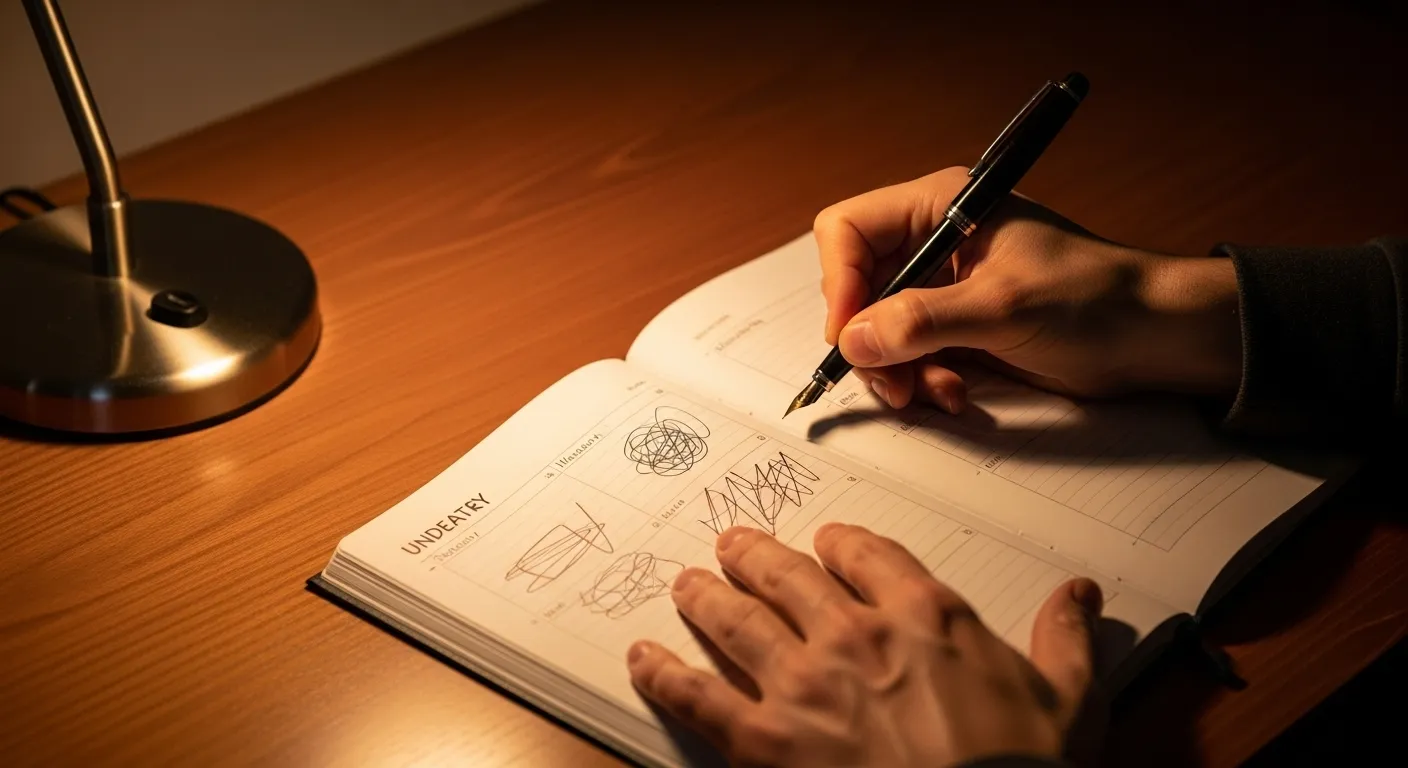
Do you ever stare at your to-do list and feel a wave of exhaustion before you even begin? You know what needs to be done. You want to do it. But a strange, invisible wall stands between you and the task. This feeling of mental friction is incredibly common. It’s the gap between intention and action, and it’s where productivity goes to die.
You might feel overwhelmed by the sheer volume of tasks. You might feel paralyzed by the need for a task to be perfect. Or you might simply be tired, your focus scattered by a thousand tiny digital pings and mental pop-ups. Whatever the cause, the result is the same: procrastination, stress, and a growing sense of being behind.
But what if you could dissolve that wall? What if you had a simple, powerful tool to bypass the friction and just… start? This is the promise of the “2-minute rule.” It’s more than just a clever productivity hack; it’s a strategy for retraining your brain, managing your energy, and building unstoppable momentum. It’s about learning how to do small tasks to build a foundation for big achievements.
In this guide, we will explore the “two minute rule” explained in a practical, evidence-aware way. We won’t just tell you what it is. We will show you how it works with your brain’s natural rhythms. We will provide you with focus rituals, thought tools, and real-world examples to help you reclaim your attention. This isn’t about hustle culture or grinding yourself into dust. It’s about working smarter, feeling better, and creating a sustainable system for focus. You can move from overwhelmed to in control. Let’s begin.
Disclaimer: This article is for informational purposes only. It does not constitute medical or psychological advice. Please consult with a qualified professional for any health concerns.
📚 Table of Contents
- Understanding Your Brain’s Attention Model
- The Two Minute Rule: Explained and Expanded
- Building Your Focus Rituals Around the 2-Minute Rule
- The Startup Ritual (5 Minutes)
- The Deep Work Entry Ritual (2 Minutes)
- Break Hygiene Ritual (2 Minutes)
- The Shutdown Ritual (5 Minutes)
- Your 15-Minute Focus Starter Pack
- Thought Tools: Mastering Your Inner Dialogue
- Reframe Perfectionism as Procrastination
- Audit and Reduce Friction
- Script Your Reset After Derailment
- Worked Examples: The 2-Minute Rule in Action
- Frequently Asked Questions About Focus and Productivity
- Does listening to music or white noise actually help with focus?
- Is multitasking really a myth? I feel like I’m good at it.
- What should I do when my motivation completely disappears?
- How can I apply these principles if I work evenings or have an irregular schedule?
- Your 7-Day Focus Challenge: Putting It All Into Practice
Understanding Your Brain’s Attention Model
To truly master your focus, you first need to understand the machine doing the focusing: your brain. Our brains are not tireless computers. They are biological organs with finite energy, specific operating modes, and predictable patterns. When you feel distracted or overwhelmed, you aren’t “broken” or “lazy.” You are simply experiencing the natural output of a system under strain.
Think about your attention as a muscle. It can be trained and strengthened, but it can also be fatigued. Every decision you make, every notification you check, and every task you juggle draws from the same limited pool of mental energy. This mental effort is what psychologists refer to as cognitive load. Cognitive load is the total amount of information your working memory can handle at one time. When you try to hold too many things in your head—your project deadline, what to make for dinner, that email you need to send, the five tabs open in your browser—you overload the system. The result is mental fog, difficulty concentrating, and poor decision-making.
One of the biggest drains on our cognitive resources is something we do constantly: context switching. This is the act of shifting your attention from one unrelated task to another. For example, you’re writing a report, and an email notification pops up. You click it, read the email, and decide to reply. Then you go back to your report. It seems harmless, but that switch wasn’t free. Your brain has to disengage from the report, load the “context” of the email, perform the new task, and then try to reload the original context of the report. Research suggests that heavy context switching can cost you up to 40% of your productive time. It shatters your focus and leaves you feeling busy but not productive.
The antidote to context switching is monotasking, or single-tasking. This means dedicating your full attention to one thing at a time. It’s in this state of deep, singular focus that we can achieve what’s known as a flow state. Flow is that magical feeling of being completely absorbed in an activity. Time seems to disappear, your work feels effortless, and your performance skyrockets. Flow is the peak of productivity and engagement, but it’s impossible to achieve when you’re constantly switching contexts.
So where does the 2-minute rule fit in? It’s the key that unlocks the door to monotasking and flow. The biggest barrier to starting a task is often the perceived effort. The task looms large in our minds, creating a huge amount of cognitive load before we even begin. The 2-minute rule drastically lowers that barrier. It tells your brain, “This isn’t a big deal. We’re just going to do this for 120 seconds.” This simple trick bypasses the brain’s threat-detection system (which flags big, scary tasks as something to avoid) and gets you into motion. And as Newton’s first law states, an object in motion stays in motion. Getting started is always the hardest part.

The Two Minute Rule: Explained and Expanded
At its core, the 2-minute rule is brilliantly simple. It was popularized by author David Allen in his productivity classic, “Getting Things Done.” The rule has two parts, and understanding both is key to using it effectively.
Part 1: If a task takes less than two minutes, do it now.
This is the classic application of the rule. Think about all the tiny tasks that populate your mental to-do list throughout the day. Replying to a simple text. Putting your mug in the dishwasher. Filing a document. Hanging up your coat. Each of these tasks on its own is trivial. But when they accumulate, they create a heavy and persistent cognitive load. They become an open loop in your brain, a constant, low-level hum of “I still need to do that.”
Deciding to do them later is often less efficient than doing them immediately. The mental energy spent remembering, deferring, and eventually returning to the task is far greater than the energy required to simply complete it on the spot. By adopting this part of the rule, you clear out the mental clutter. You close those loops. This creates a cleaner, quieter mental workspace, freeing up your cognitive resources for the work that truly matters. This is the ultimate strategy for how to do small tasks efficiently.
Part 2: When starting a new habit or a large task, it should take less than two minutes to start.
This is the more profound, life-changing application of the 2-minute rule, developed further by author James Clear. Almost any large goal or project can be scaled down into a two-minute version. The goal is not to finish the task; the goal is to simply start. The real magic of the 2-minute rule is that it bypasses the twin demons of procrastination: perfectionism and overwhelm.
Want to build a reading habit? The goal is to read one page. Not a chapter, not 30 minutes. Just one page. Anyone can read one page. Want to get in shape? The goal is to put on your running shoes and walk out the door. You don’t have to run five miles. You just have to start. Want to write a book? The goal is to open your document and write one sentence.
This approach works because it shifts your focus from the outcome (which can be intimidating) to the process (which is manageable). It makes starting so easy, so ridiculously simple, that you can’t say no. It builds a “show up” habit. And once you’ve shown up, once you’ve started, momentum often takes over. Reading one page often turns into ten. Writing one sentence often sparks an idea for a paragraph. Putting on your running shoes often leads to a walk, which might just turn into a run. But even if it doesn’t, you still win. You showed up. You reinforced your identity as someone who reads, who exercises, who writes. You built a tiny bit of momentum, which is infinitely more powerful than the inertia of doing nothing.
This is why the 2-minute rule is one of the most effective productivity hacks. It’s not about the two minutes. It’s about the “getting started” ritual. It’s a gateway to deeper, more sustained focus. It transforms daunting tasks into a series of simple, achievable starting points.

Building Your Focus Rituals Around the 2-Minute Rule
Consistency is born from rituals, not from sheer willpower. Willpower is a finite resource that drains throughout the day. Rituals, on the other hand, are automated behaviors that require very little mental energy. By building simple rituals around your workday, you can conserve your willpower for the challenging tasks themselves. The 2-minute rule is the perfect building block for these focus-enhancing routines.
The Startup Ritual (5 Minutes)
How you start your day often determines the quality of the entire day. Instead of diving straight into your inbox and letting other people’s priorities dictate your morning, take five minutes to intentionally set up your mind and your environment. A startup ritual signals to your brain that it’s time to focus.
Your 2-minute action: Clear your physical and digital workspace. Take 120 seconds to put away stray papers, close unnecessary browser tabs, and wipe down your desk. A clean environment reduces visual distractions and lowers cognitive load. It sends a powerful message: this space is for focused work.
The rest of the ritual: After clearing your space, take three minutes to look at your main to-do list and identify your single most important task for the day. Write it down on a sticky note and place it on your monitor. This single act of prioritization prevents decision fatigue later on.
The Deep Work Entry Ritual (2 Minutes)
The transition from “getting ready to work” to “actually working” is a major friction point. This is where procrastination loves to strike. The deep work entry ritual uses the 2-minute rule to make this transition frictionless.
Your 2-minute action: Perform the smallest possible step of your most important task. If you need to write a report, your 2-minute action is to open the document and write the title. If you need to analyze data, your action is to open the spreadsheet. If you need to code, your action is to write a single line of a comment explaining what you’re about to do. That’s it. You are simply lowering the barrier to entry so much that it feels absurd not to do it. More often than not, this tiny step is enough to get the engine running.
Break Hygiene Ritual (2 Minutes)
Breaks are not a sign of weakness; they are a biological necessity for sustained performance. Your brain needs downtime to recharge and consolidate information. However, most people take “bad” breaks. They switch from focused work on their computer to scrolling through social media on their phone. This isn’t a real break; it’s just a different kind of cognitive load.
Your 2-minute action: Look away from all screens and get a glass of water. Stand up, stretch, and walk to the kitchen. Look out a window at something in the distance to relax your eye muscles. Focus on the physical sensation of drinking the water. This simple act disconnects you from the digital world, rehydrates your body and brain, and provides a true mental reset. It’s one of the most effective quick tasks for mental clarity.
The Shutdown Ritual (5 Minutes)
Just as a startup ritual is crucial for beginning your day, a shutdown ritual is essential for ending it cleanly. It prevents work from bleeding into your personal time, which is a major cause of burnout. It tells your brain that the workday is officially over, allowing it to fully disengage and recover.
Your 2-minute action: Organize your workspace for tomorrow. This is the inverse of your startup ritual. Straighten your papers, plug in your devices, and put away your tools. You are creating a welcoming, friction-free environment for your future self. It’s a two-minute gift that pays huge dividends the next morning.
The rest of the ritual: After tidying up, take three minutes to review what you accomplished today. Close any open loops by either completing any lingering 2-minute tasks or scheduling them for tomorrow. Finally, say a specific phrase out loud, like “Shutdown complete.” This verbal confirmation helps create a powerful psychological boundary between work and rest.
Your 15-Minute Focus Starter Pack
Feeling overwhelmed by all this? Don’t be. Start small. Here is a simple, 15-minute routine you can try tomorrow, built entirely from these principles.
Morning (5 mins): Perform your Startup Ritual. Clear your space, identify your main task.
Start of Work (2 mins): Perform your Deep Work Entry Ritual. Do the tiniest first step of your main task.
Mid-Morning (2 mins): Perform your Break Hygiene Ritual. Get water, look out a window.
End of Day (5 mins): Perform your Shutdown Ritual. Tidy up, review your day.
That’s it. Just 14 minutes of intentional action to structure your entire workday for better focus and less stress.

Thought Tools: Mastering Your Inner Dialogue
The external world is full of distractions, but often the biggest obstacles to focus exist between our own ears. Our mindset, self-talk, and ingrained beliefs can create more friction than any email notification ever could. The 2-minute rule isn’t just an action-oriented tool; it’s also a powerful mental lever. Here’s how to use it to re-wire your internal dialogue for productivity.
Reframe Perfectionism as Procrastination
Perfectionism sounds like a noble trait, but in practice, it’s often just a fancy word for fear. It’s the fear of being judged, the fear of not being good enough, the fear of failure. This fear makes starting a task feel like a monumental undertaking because the finished product has to be flawless. This is where the 2-minute rule becomes your secret weapon.
The Thought Tool: Instead of thinking, “I have to write a perfect report,” your new thought is, “I just have to open the document and write one sentence for two minutes.” You are giving yourself permission to be imperfect. You are prioritizing starting over finishing. The goal is not excellence; the goal is motion. You can’t edit a blank page. The 2-minute rule helps you create the messy first draft, the imperfect prototype, the raw material that you can then refine later. It separates the act of creating from the act of editing, which are two very different cognitive processes.
Audit and Reduce Friction
Every task has a certain amount of friction associated with it—the small, annoying steps you have to take before you can get to the actual work. For exercising, the friction might be finding your workout clothes. For writing, it might be locating the right file on your messy desktop. Our brains are wired to follow the path of least resistance, so if a good habit has high friction, we’ll often opt for an easy distraction instead.
The Thought Tool: Ask yourself, “What is one thing I can do in under two minutes to make my most important task easier to start tomorrow?” This simple question prompts you to become an architect of your own environment. If you want to go for a run, lay out your clothes the night before. If you want to write, create a shortcut to the document on your desktop. If you want to eat a healthy breakfast, take out the blender and ingredients before you go to bed. Use these tiny, two-minute actions to systematically remove the barriers between you and your goals. You are making it easy to do the right thing.
Script Your Reset After Derailment
No matter how good your systems are, you will get distracted. You will fall off track. It’s a part of being human. The crucial moment is not the distraction itself, but what happens immediately after. Many people fall into a spiral of shame and self-criticism. “Ugh, I can’t believe I just wasted 30 minutes on social media. My focus is terrible. The whole day is ruined now.” This negative self-talk only deepens the inertia and makes it harder to get back to work.
The Thought Tool: Create a simple, non-judgmental reset script. The moment you realize you’ve been derailed, say it to yourself. It could be something like: “Okay, that happened. Back to it.” Or “Distraction noted. What’s the next tiny step?” Your 2-minute action is to immediately apply the deep work entry ritual. Don’t dwell on the distraction. Don’t analyze why it happened. Just gently and firmly guide your attention back to the smallest possible next action. Open the document. Re-read the last sentence you wrote. This compassionate, action-oriented reset prevents a minor distraction from turning into a major productivity catastrophe.

Worked Examples: The 2-Minute Rule in Action
Theory is helpful, but seeing these principles applied to real-world scenarios makes them much more tangible. Let’s walk through two common situations where focus is a challenge and see how the 2-minute rule and its associated rituals can make a difference.
Scenario 1: The Tight Deadline
The Situation: It’s 1 p.m., and Sarah has a major presentation to finish for her boss by the end of the day. The pressure is on, and she’s feeling paralyzed. The task feels so huge and important that she doesn’t know where to start. She finds herself checking emails, tidying her desk—anything to avoid the main task. This is classic overwhelm leading to procrastination.
The 2-Minute Solution:
- Reset Script: Sarah recognizes the feeling of paralysis. She tells herself, “Okay, feeling overwhelmed. What’s the smallest possible step?”
- Deep Work Entry Ritual: She decides her 2-minute action is not to “work on the presentation,” but to “open the PowerPoint file and create a single slide with only the title on it.” This is so simple it feels almost silly, but it breaks her inertia.
- Momentum: After creating the title slide, she thinks, “Okay, I can make the agenda slide. That’s easy.” She does that in a few minutes. Now she has two slides. The document is no longer a scary blank page. The momentum has begun. She has moved from a state of avoidance to a state of engagement.
- Break Hygiene: After working for 45 minutes, she feels her focus waning. Instead of checking her phone, she uses a 2-minute break ritual. She stands up, walks to the window, and drinks a glass of water. This quick, screen-free reset allows her to return to the task with renewed clarity, avoiding the “attention residue” that comes from checking email or social media.
By using these small, structured actions, Sarah navigates her way out of overwhelm. The 2-minute rule didn’t finish the presentation for her, but it was the key that started the engine.
Scenario 2: The Noisy Home Environment
The Situation: Mark works from home and struggles to focus. The dog is barking, a delivery arrives, and he can hear his family in the next room. His environment is full of unpredictable interruptions, making it nearly impossible to get into a state of flow. He feels frustrated and his productivity plummets after every interruption.
The 2-Minute Solution:
- Startup Ritual: Mark knows the day will be chaotic. He starts his day with a 5-minute startup ritual before the rest of the house is awake. His 2-minute action is to close all browser tabs from the previous day, creating a clean digital slate. He then identifies his one critical task that requires the most focus.
- Friction Reduction: Mark’s 2-minute thought tool is, “How can I make it easier to focus?” He decides to take 120 seconds to put on his noise-canceling headphones and open his “focus playlist” before he even sits down to work. He has created an environmental cue for “deep work time.”
- Reset Script After Interruption: A delivery person rings the doorbell, pulling him away from his work. After signing for the package, his old habit would be to feel annoyed and check his phone. Instead, he uses his reset script: “Interruption over. Back to it.”
- Deep Work Re-Entry: He doesn’t try to jump back into the complex problem he was solving. He uses a 2-minute re-entry ritual. His action is to simply re-read the last paragraph he wrote. This small step reloads the context of his work into his brain without a huge amount of mental effort, allowing for a much smoother transition back into a focused state.
Mark can’t control his environment completely, but the 2-minute rule gives him tools to manage his reaction to it. He uses it to create pockets of focus and to recover quickly from the inevitable distractions of working from home.

Frequently Asked Questions About Focus and Productivity
As you begin to implement these ideas, questions will naturally arise. Here are answers to some of the most common queries we see at TheFocusedMethod.com, helping you troubleshoot and refine your approach.
Does listening to music or white noise actually help with focus?
The answer is highly individual, but science can offer some guidance. For many people, silence is not golden; it’s distracting, allowing their minds to wander. Ambient noise, like the hum of a fan, or specific types of audio can help. White noise, for example, can mask sudden, jarring sounds from your environment, creating a more stable “auditory wall.” Music is trickier. Music with lyrics can be very distracting because it engages the language-processing centers of your brain, competing for the same resources you need for writing or analysis. For this reason, many people find instrumental music, classical pieces, or specifically designed “focus music” (often found on streaming services) to be more effective. The key is to experiment. Try different soundscapes and see what works for you. The goal is a consistent, predictable sound environment that your brain can eventually tune out, allowing you to focus on the task at hand.
Is multitasking really a myth? I feel like I’m good at it.
This is a common belief, but the neurological evidence is clear: true multitasking (performing two or more cognitively demanding tasks simultaneously) is a myth. As leading scientific bodies like the American Psychological Association have noted, what we call multitasking is actually rapid context switching. Your brain isn’t doing two things at once; it’s just switching back and forth between them very quickly. As we discussed earlier, this process comes with a significant cognitive cost. It burns through mental energy, increases the likelihood of errors, and makes it impossible to achieve a deep state of flow. While you might feel productive because you’re busy, your actual output is often lower in both quantity and quality. The only exception is pairing a highly automated task (like walking) with a cognitive one (like listening to a podcast). For any serious knowledge work, monotasking is always the more effective path.
What should I do when my motivation completely disappears?
Motivation is a fickle emotion; it comes and goes. Relying on motivation to be productive is a losing strategy. This is where the power of rituals and the 2-minute rule truly shines. On days when you feel zero motivation, don’t try to force yourself to “feel” like working. Instead, fall back on your system. Honor your commitment to the process, not the outcome. Tell yourself, “I don’t feel like it, but I will honor my deep work entry ritual. I will just open the file and write one sentence.” You are negotiating with your brain on the smallest possible terms. Often, this tiny act of showing up is enough to generate a little bit of momentum. And momentum is the most powerful source of motivation. Action precedes motivation, not the other way around. Don’t wait to feel good to start; start to feel good.
How can I apply these principles if I work evenings or have an irregular schedule?
The principles of focus are universal and not tied to a traditional 9-to-5 schedule. The key is to create clear boundaries and rituals, regardless of when your “workday” happens. A “startup ritual” is simply what you do at the beginning of any dedicated work block. If your work block starts at 9 p.m., that’s when you do your 5-minute ritual to clear your space and set your intention. A “shutdown ritual” is what you do at the end of that block, even if it’s 2 a.m. This ritual is arguably even more important for night owls, as it signals to the brain that it’s time to wind down for sleep. The structure provided by these routines can be a powerful anchor, especially when your schedule is unpredictable. The specific times don’t matter; the consistent, intentional process does.
For more information on the science of cognition and mental health, you can visit a trusted resource like the National Institutes of Health homepage.

Your 7-Day Focus Challenge: Putting It All Into Practice
Reading about focus is one thing. Building the skill of focus is another. The best way to see if these methods work for you is to try them. We challenge you to commit to a simple, seven-day experiment. Don’t try to change everything at once. Just pick a few small, high-impact actions and practice them consistently. The goal is not perfection; it’s practice.
Here are three focus actions to try for the next seven days. They are designed to be simple, effective, and built around the principles we’ve discussed. Track your experience in a notebook. How did you feel before and after? What was difficult? What came easily?
1. Master the Classic 2-Minute Rule. For one week, make a conscious effort to follow Part 1 of the rule: If a task appears in your mind and you know it will take less than two minutes, do it immediately. Don’t write it down. Don’t defer it. Just do it. This could be rinsing your coffee cup, responding to a quick text message, or putting a file away. Notice how this small habit impacts your sense of mental clutter and accomplishment at the end of the day.
2. Implement the Bookend Rituals. Commit to a 5-minute Startup Ritual at the beginning of your workday and a 5-minute Shutdown Ritual at the end. That’s it. Just ten minutes a day. The startup ritual involves your 2-minute tidy and identifying your top priority. The shutdown ritual involves a 2-minute tidy for the next day and a quick review of your accomplishments. These “bookends” will create powerful structure and psychological boundaries for your workday.
3. Use a “Gateway” Habit for Your Hardest Task. Identify the one task on your list that you are most likely to procrastinate on. For the next seven days, your only goal for that task is to perform a 2-minute “gateway” action. Don’t worry about working on it for an hour. Your only job is to start. Open the file. Put on your running shoes. Write one email sentence. Just show up for 120 seconds. If you feel like continuing after the two minutes are up, great. If not, you still succeeded. You showed up. That’s the win.
This challenge is not about revolutionizing your productivity overnight. It’s about taking small, deliberate steps to build a better relationship with your own attention. It’s about proving to yourself that you can bypass the friction and take control. You have the tools. You understand the principles. Now is the time for gentle, consistent action. Start small, and see what big changes follow.






